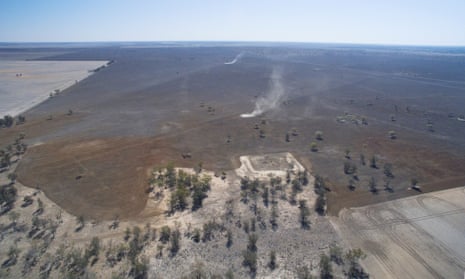Australia is likely to be releasing more emissions from deforestation than reported to the United Nations, new analysis indicates, stoking calls for an independent review of the sector that has delivered the bulk of the country’s claimed reductions in greenhouse gas pollution in recent decades.
An assessment of satellite imagery of more than 50 properties in Queensland by Martin Taylor, an adjunct senior lecturer at the University of Queensland, has identified significant discrepancies between what is treated as cleared land by Australia’s National Carbon Accounting System (NCAS) and the Statewide Landcover and Trees Study (Slats) used by the state government.
“It flummoxes me – what’s going on in their models when they are missing such obvious land clearing,” Taylor said. “How can you possibly say that’s still forest … it’s so glaringly obvious something is wrong.”
How countries have treated emissions from the land sector – clumsily known as Land Use, Land Use Change and Forestry (LuluCF) – has been contentious for decades, partly because of the challenges of accurately measuring and monitoring what can be subtle changes in vegetation even between seasons and periods of drought and wet spells.
The Australian government has relied on its reporting of falls in land-clearing rates for almost all the reductions that allow it to claim the country’s emissions have fallen by about one-fifth since 2005, and that Australia has “over-achieved” on its pledged cuts under the Kyoto protocol.
An accurate estimate of changing vegetation cover also underpins the veracity of carbon offsets, with the majority of claimed cuts paid for through the federal government’s emissions reduction fund going to the land sector. Its new long-term emission reduction plan to reach net zero by 2050 also relies heavily on it.
“Emissions from [LuluCF] have fallen by 114m tonnes of carbon dioxide-equivalent since 2005, and in 2019 the sector represented a 25 Mt CO₂-e sink for Australia,” the government’s net zero plan report states. Australia reports annual emissions of about 500m tonnes.

Deforestation has featured at Cop26 the climate summit in Glasgow, with Australia among the 105 nations to sign a pledge to reduce forest loss by 2030.
Accounting rules agreed to under the UN framework convention on climate change help countries minimise loss of their forests. Under those rules, tree crown cover needs to amount for only 10% to 30% of an area of less than one hectare for it to be treated as a forest. Australia takes the mid-point of the range at 20%.
Taylor said the 20% estimate was “a fundamental issue” that meant NCAS “just completely misses” land clearing.
“Where forest tree cover gets reduced down from 100% to 30% or 20%, to them it’s still a forest and nothing’s changed,” he said. “That’s huge.”
Taylor and other researchers said even 20% coverage could be understating actual clearing because the models used are less accurate than the Slats detection used by Queensland and other states, including NSW.
It isn’t clear what land-clearing is
Questions over the reliability of Australia’s land sector emissions accounting are not new.
As far back as 2007, Andrew Macintosh of the Australian National University law school called for an independent review of NCAS, without which the “federal government’s claims about Australia’s performance against its Kyoto target should be treated with scepticism”.
Glenn Walker, then with the Wilderness Society, also compiled a report highlighting how Queensland’s land clearing rates rocketed after the LNP under Campbell Newman came to power in 2012, yet Australia’s emissions continued to fall during that period.
Excluding land use, national emissions had risen by more than 5% since 2005 – the base year picked by the Abbott government for Australia’s Paris climate goal – before Covid-19 lockdowns began. Carbon pollution in other rich economies fell in that timeframe.
Researchers say there are “millions of anecdotes” to illustrate areas where land-clearing has been picked up by Slats, but not by NCAS. One case involved NCAS identifying a dam as a forest because of its dark colour.
Don Butler, an ecologist formerly at the Queensland Herbarium and now a professor at ANU, worked with the Slats program for years. He said NCAS used Landsat imagery at 25m to detect vegetation and alterations, while Slats used 10m pixels.
“Just that change alone will change the estimate of the area cleared,” he said.
Stuart Phinn, a professor at the University of Queensland specialising in the use of remote sensing to measure environmental changes, said Newman’s policies “did have a large impact on clearing” that were picked up by Slats.
Reports at the time estimated Queensland landholders were clearing 10 sq km a day in 2015-16. The environment minister, Steven Miles, estimated carbon emissions at 45m tonnes over that year.
Slats doesn’t itself calculate emissions. As with NCAS, the emissions are inferred by the vegetation change identified in satellite images that is assessed using complex algorithms. The next Slats report for 2018-19 will be released by the end of 2021.
Butler said: “The reason Slats is more accurate is that a human looks at every bit of clearing that’s reported and decides that it is clearing, and that’s not something that NCAS is resourced to do.”
Phinn, Butler and other researchers do not suggest there is any intent by NCAS to mislead on emissions, but stress the need for more transparency.
“It would be good to go more public with their modelling validation,” Phinn said. “I don’t think it’s open enough.”
The emissions reduction minister, Angus Taylor, passed a request for comment to the energy department, which said any suggestion that the Australian government had underestimated land clearing was “misplaced”.
“The Australian government prepares the national greenhouse accounts in accordance with Intergovernmental Panel on Climate Change guidelines,” a department spokesperson said, citing the approach detailed in the national inventory report.
“The methods and data are reviewed every year by teams of international experts assembled by the UNFCCC secretariat in Bonn. The international architecture that governs the National Greenhouse Accounts is designed to give confidence that the data are accurate, comparable and time-series consistent.”
‘It’s hard to understand and it’s hard to explain’
Martine Maron, professor of environmental management at the University of Queensland, said the complexity of the processes was one reason emissions from land clearing had not drawn as much public scrutiny.
“It’s a huge issue in Australia,” Maron said. “It’s been a problem for a long time. It’s really, really hard to understand and it’s hard to explain.”
“Essentially [NCAS and Slats] are using the same input data but they’re classifying change in different way,” she added. “I’ve spent years trying to get my head around it.”
Butler said there were reasons to question the accounting even after recent revisions, including the increasing area assessed to be regrowth on previously cleared land.
“It’s now worth about 10-12m tonnes [of CO2] of sequestration a year,” he said. “That’s the bit … I have the least faith in I suppose, and it is a significant part of the story.”
Head of consulting at Ndevr Environmental, Matt Drum, and also formerly with the federal department of climate change, said land use changes were not reliably calculated, so his firm focused on tracking carbon emissions by the rest of the economy.
“It’s not a bit of a black box, it’s a massive black box,” Drum says. “It’s at the point where you report without LuluCF – it’s much more reliable.”
The Greens leader, Adam Bandt, said Scott Morrison “boasts of meeting and beating terrible targets, but his claimed 20% emissions cuts [since 2005] rely on accounting changes that the experts now question”.
“Take out the land sector and it’s unstable greenhouse accounting and the Liberals haven’t reduced emissions since 2005 at all,” Bandt said.
Phinn and Butler said space-based remote sensing was rapidly advancing and systems would soon be available that more precisely detected height and density of vegetation, so that regrowth of grass, for instance, was not treated as if it were more woody plants. Whether governments use the technology to adjust and even reinterpret past data is another matter.
With the land sector also accounting for more than 60% of Australian carbon credits and more than three-quarters of contracted abatement under the ERF, potentially billions of dollars of offsets and sequestration claims are riding on good data.
Will Steffen, a researcher at ANU, helped advise the Labor government under Julia Gillard on how to nudge companies to reduce their emissions rather than rely on offsets to do their work.
“[We wanted] to make sure that there wasn’t a get out of jail free card by using land offsets in place of actually reducing fossil fuel emissions,” Steffen said. “The land sector screamed up and down that that wasn’t fair because then as now there are companies in those industries who make money off offsets.”
Steffen said: “I think we need a really thorough review of the entire land clearing process. That’s not just accounting, but how we use land carbon vis-a-vis fossil fuel emissions.”
